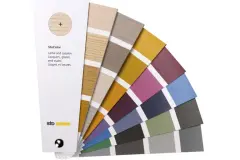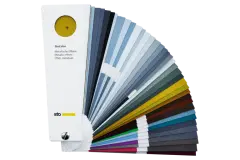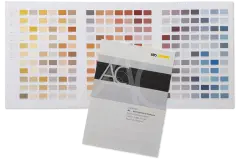StoColor System
Resources & tools for colour selection1,000 colour shades, endless possibilities
The coordinate-based StoColor System delivers a whole host of composition options for architectural and interior design scenarios.
Based on a colour wheel with 72 colour areas, 24 natural white nuances as well as 6 black tones, a series of 48 graduations of greys are at your disposal. To help you select the suitable colour, we offer a range of colour fans, colour cards as well as boxes and downloadable files for use with most illustration tools such as Adobe Photoshop and SketchUp. The professional colour tools available indicate, via the LRV (light reflectance value) and the TSC (total solar reflectance), the suitability of certain Sto materials in regard to specific situations and use.
Download the StoColor 2022 Ebook overview
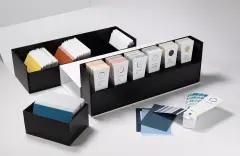
One concept, perfect tools, safe application
Peter Appenzeller and Antonio Romano from StoDesign were significantly involved in the development of the new StoColor system.
"We wanted to develop a system that offers clear benefits in application beyond existing colour systems: with an intelligent system that provides users with 'recipes' for the composition of colour tones."
The StoColor System - a summary
- 1,000 colours for facades, including 24 shades of white, 6 shades of black, 16 shades of neutral greys & 48 shades of 3% chroma greys
- 225 shades for interiors
- 200 lacquer shades
- 38 wood glaze shades
- 72 shades with a historical or architectural reference
- over 60 shades available with metallic effect

Sto offers professional color tools to indicate the LRV (Light Reflectance Value), and the TSR (Total Solar Reflectance) and indicate the suitability of certain Sto materials in specific applications.
- LRV - Light Reflective Value
The lightness (or brightness) value (LRV) is the amount of white or black mixed in with the colour. It's also calculated as a percentage value between 0% and 100%. 0% lightness will always be black. - TSR - Total Solar Reflectance
The TSR value describes the solar reflection capability of a pigmented surface, representing the percentage of solar radiant energy that is reflected. The larger the value, the more the solar radiation is reflected and therefore the lower the temperature increase of the surface compared to the surrounding temperature. The targeted use of pigments with a low absorption in the near infrared radiation range allows for very dark colour tones to be chosen which reduce the surface temperature. Specifically, thermally insulated surfaces can benefit from this technique in terms of longevity.
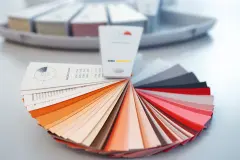
Digital resources for StoColor System
- ASE palettes for ADOBE programmes (.zip, 21.5 KB)
- BMP paint textures (.zip, 633 KB)
- JPG paint textures (.zip, 2.81 MB)
- SketchUp (.zip, 3.59 MB)
- Colour values in an Excel file format (.xlsx, 367 KB)
- Colour values in csv file format (.zip, 128 KB)
- Colour values in xml file format (.zip, 71.4 KB)
- Colour values in json file format (.zip, 70.5 KB)
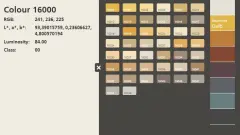
The StoDesign Architectural Colour selection
Sto's Architectural Colours (AC) consist of 300 colour shades for modern architectural colour design and is the ideal supplement to the tried-and-tested StoColor System. The colour choice for the AC collection focuses on durability and material-related colour schemes in the tradition of the mineral colour charts by Sto.
Products such as the silicon resin facade paints and StoColor Lotusan - the facade paint with Lotus-Effect® - can be supplied in all 300 colour shades. Many of the colour shades are suitable for organic and mineral external wall insulation systems. Due to their mineral and very light-resistant pigments in all 300 colour shades, the coatings boast maximum colour resistance A1 in accordance with the Fb code.
Visit the interactive Architectural Colour tool
Exact digital textures: Realistic CGI facade rendering
Photorealistic computer graphics are now ubiquitous. Sto offers a physically-based approach to rendering, where an accurate modelling of the physics of light scattering is at the heart of image synthesis. With our data-based files, the user can offer visual realism as well as predictability of appearance.
Physically Based Rendering (PBR), the scanning of actual Sto surfaces, is more than mere simulation - this concept combines human-readable documentation and source code into a single reference that is specifically designed to aid comprehension. The files provided allow you to design and employ a full-featured rendering system capable of creating stunning imagery.
Why use physically based rendering?
Physically based rendering (PBR) is the concept of using realistic shading/lighting models along with measured surface values to precisely represent real-world materials - in this case Sto facade plasters and surfaces - to accurately create authentic 3D models. The files are available in 8k resolution. Due to the size of these files, please contact us for a download link.

Please note that due to the nature of screen colours and monitor calibration, the colours that are displayed here may appear different to the real thing, and are provided for reference/illustration only. For a true representation of a StoColor, please contact your local Sto representative to request a samples, colour cards and other tools. Contact us
How can I help?
We need your consent to load Salesforce Marketing Cloud Account Engagement.
We use a third-party service to embed contact forms and make it available to you. By clicking “Accept”, you consent to your data being processed by Salesforce Marketing Cloud Account Engagement in accordance with our CMP. You can find out more about the service by clicking “More information”. You can withdraw consent with effect for the future at any time.
We are Sto, how can we help you?
-
 Audra Lee Sto Singapore
Audra Lee Sto Singapore -
 Otto Norling Sto Sweden
Otto Norling Sto Sweden -
 Wei Zhuang Sto China
Wei Zhuang Sto China -
 Riccardo Rossi Sto Italia
Riccardo Rossi Sto Italia -
 Mark Harris Sto Gulf Region
Mark Harris Sto Gulf Region -
 Murat Yarar Sto Turkey
Murat Yarar Sto Turkey



